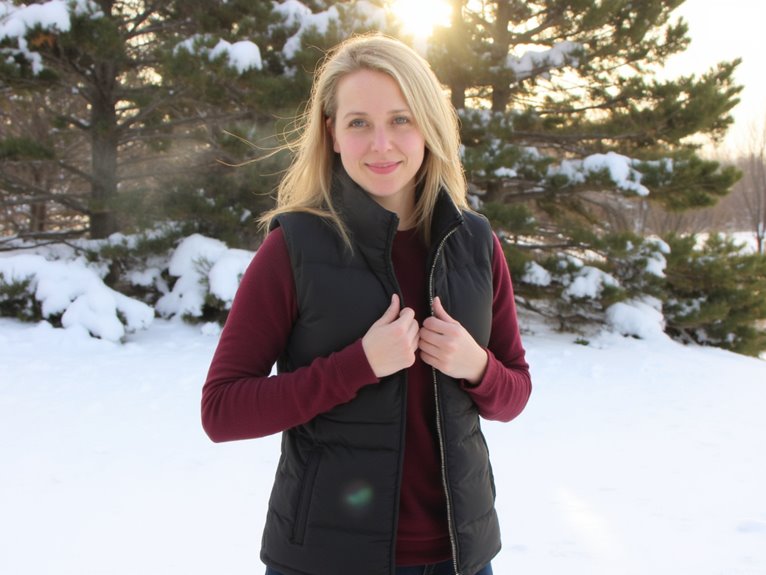Are Snowshoes Good for Deep Snow?
Snowshoes are specifically designed to help you navigate deep snow with ease, providing the necessary buoyancy, traction, and stability to stay afloat and move efficiently through dense, powdery snow. Features like larger, tapered frames, narrower waists, and aggressive crampons enable snowshoers to stay atop the snow's surface, reducing fatigue and improving mobility. A well-designed snowshoe can support substantial weight capacities, making them ideal for exploring deep snow. To guarantee a comfortable and efficient snowshoeing experience, it's crucial to choose the right snowshoe size and design for your specific needs – and there's more to discover about optimizing your snowshoeing adventure.
We are supported by our audience. When you purchase through links on our site, we may earn an affiliate commission, at no extra cost for you. Learn more. Last update on 21st December 2025 / Images from Amazon Product Advertising API.
Snowshoe Design for Deep Snow
Ideal snowshoe design for deep snow typically features a larger, more tapered frame with a narrower waist, allowing for improved floatation and easier traversal through dense, powdery snow.
This design enables the snowshoer to stay atop the snow's surface, reducing the likelihood of sinking or post-holing.
A larger frame also provides a wider surface area, distributing the wearer's weight more evenly and increasing overall stability.
Additionally, a narrower waist allows for a more efficient stride, reducing fatigue and improving overall mobility.
When selecting snowshoes for deep snow, look for models with a larger, more tapered frame and a narrower waist to facilitate a comfortable and efficient snowshoeing experience.
How Much Weight Can They Hold
Typically, snowshoes designed for deep snow are engineered to support a substantial amount of weight, with most models capable of holding between 150-300 pounds, depending on the brand, model, and materials used.
This weight capacity is often dependent on the type of decking material, frame design, and overall construction of the snowshoe. For example, snowshoes with a sturdy aluminum frame and durable decking can support heavier loads, while lighter models may have a lower weight capacity.
It's vital to check the manufacturer's specified weight limit to guarantee safe and enjoyable snowshoeing experiences.
Additionally, it's essential to take into account not only the user's weight but also the weight of any additional gear, such as backpacks or equipment.
Buoyancy in Deep Powder Explained
In deep powder, snowshoes rely on buoyancy to stay afloat, which is achieved through a combination of the deck's surface area, the shape of the frame, and the material's ability to displace snow.
When a snowshoer steps into deep powder, the snowshoes act like a flotation device, allowing them to stay on top of the snow. This is vital in deep snow, where sinking is a real concern.
Some key factors that contribute to buoyancy in deep powder:
- Deck size and shape: Larger decks provide more surface area, increasing buoyancy.
- Frame material: Lightweight, durable materials like aluminum or carbon fiber help reduce sinkage.
- Crampons and traction: Aggressive crampons and traction systems help maintain stability and prevent slipping.
- Deck angle and tilt: Adjustable decks allow for customized angle and tilt to optimize buoyancy.
- Strap and binding system: A secure, comfortable strap and binding system guarantees a stable connection to the snowshoe, allowing the snowshoer to stay afloat.
Benefits of Large Snowshoe Decks
Larger snowshoe decks, which provide increased surface area, are particularly beneficial in deep powder as they enable snowshoers to stay afloat with greater ease, making them an attractive option for those who frequently venture into extreme snow conditions.
This increased surface area allows snowshoers to displace their weight more efficiently, reducing the likelihood of sinking into the snow.
As a result, larger decks require less energy expenditure, allowing snowshoers to conserve energy and cover more ground.
Additionally, larger decks often feature a more ergonomic design, providing a more comfortable and natural stride, which is essential for traversing deep snow.
Deep Snow Traction and Grip
Achieving reliable traction and grip in deep snow requires a thoughtful combination of snowshoe design features, including aggressive crampons, strategically placed traction rails, and a well-engineered decking system that works in harmony to keep snowshoers moving confidently forward.
To facilitate reliable grip in deep snow, look for snowshoes with:
Aggressive crampons that bite into the snow
Strategically placed traction rails for added stability
A decking system that allows for maximum floatation and traction
A frame design that allows for a natural stride
A binding system that securely holds the foot in place
Snowshoe Frames for Deep Snow
Optimizing the frame design of snowshoes for deep snow is critical, as it directly impacts the snowshoer's ability to move efficiently and maintain stability in challenging winter conditions.
A well-designed frame should provide adequate floatation, allowing the snowshoer to stay atop the snow rather than sinking into it.
Look for frames with a wider, more rounded profile, which help to distribute weight evenly and increase surface area.
This design feature enables snowshoers to traverse deep snow with greater ease and control.
Additionally, frames with a slight upward curve at the tip can help to prevent snow from accumulating on the deck, further enhancing mobility in deep snow.
Choosing the Right Snowshoe Size
When selecting snowshoes for deep snow, it's essential to choose a size that complements your body weight, as a proper fit guarantees efficient flotation and stability. A snowshoe that's too small won't provide adequate buoyancy, while one that's too large will be cumbersome and difficult to maneuver.
To guarantee a proper fit, consider the following factors:
- Your body weight: Choose a snowshoe designed for your weight range.
- The terrain you'll be exploring: Deeper snow requires a larger snowshoe.
- The type of snow: Powder snow requires a larger snowshoe than packed snow.
- Your snowshoeing style: Aggressive snowshoers may prefer a larger snowshoe for added stability.
- The manufacturer's recommendations: Check the manufacturer's sizing chart for guidance to confirm a proper fit.
Deep Snow Performance in Practice
In the domain of deep snow, where every step counts, a snowshoe's performance is put to the ultimate test, and it's here that the nuances of design and functionality come into sharp focus.
In practice, a good snowshoe for deep snow should allow you to move efficiently, without excessive sinking or struggling.
Look for features like a larger surface area, aggressive crampons, and a robust frame that can support your weight and distribute it evenly.
Additionally, consider the snowshoe's floatation, which enables it to stay atop the snow, reducing the energy expended with each step.


